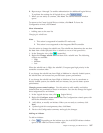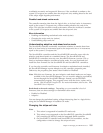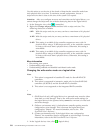
Selecting a RAID level and tuning performance
Disk arrays are used to improve performance and reliability. The amount of
improvement depends on the application programs that you run on the server and
the RAID levels that you assign to the logical drive.
Each RAID level provides different levels of fault-tolerance (data redundancy),
utilization of physical drive capacity, and read and write performance. In addition,
the RAID levels differ in regard to the minimum and maximum number of
physical drives that are supported.
When selecting a RAID level for your system, consider the following factors.
Note: Not all RAID levels are supported by all ServeRAID controllers.
RAID level
Data redun-
dancy
Physical
drive
capacity
utili- zation
Read perfor-
mance
Write perfor-
mance
Built-in
spare drive
Min.
number of
drives
Max.
number of
drives
RAID level-0 No 100% Superior Superior No 1 16
RAID level-1 Yes 50% Very high Very high No 2 2
RAID
level-1E
Yes 50% Very high Very high No 3 16
RAID level-5 Yes 67% to 94% Superior High No 3 16
RAID
level-5E
Yes 50% to 88% Superior High Yes 4 16
RAID
level-5EE
Yes 50% to 88% Superior High Yes 4 16
RAID level-6 Yes 50% to 88% Very High High No 4 16
RAID
level-00
No 100% Superior Superior No 2 60
RAID
level-10
Yes 50% Very high Very high No 4 16
RAID
level-1E0
Yes 50% Very high Very high No 6 60
RAID
level-50
Yes 67% to 94% Superior High No 6 60 (SCSI) 128
(SAS, SATA)
RAID
level-60
Yes 50% to 88% Very High High No 8 128
Spanned
Volume
No 100% Superior Superior No 2 48
RAID
Volume
No 50% to 100% Superior Superior No 4 48
Physical drive utilization, read performance, and write performance depend on the
number of drives in the array. Generally, the more drives in the array, the better
the performance.
More information
v Understanding RAID technology
v Selecting the logical drive size
v Selecting the RAID level by array capacity
v Creating logical drives (action)
190 ServeRAID Manager Installation and User's Guide


















